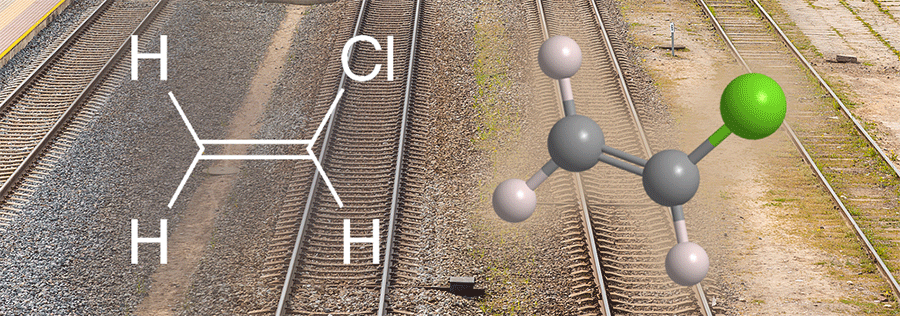What molecule am I?

Vinyl chloride is a colorless gas with a mild, sweet odor that belies how hazardous it is. (See the hazard information table.) It has been in the news lately because of the February 3 rail disaster in East Palestine, OH.
Vinyl chloride has been known since at least 1835, when Henri Victor Regnault at the University of Giessen (Germany)1 synthesized it via the reaction of 1,2-dichloroethane2 and potassium hydroxide in ethanol solution. 1,2-Dichloroethane, frequently called ethylene dichloride, is still the precursor to vinyl chloride today. In 2021, the worldwide market for vinyl chloride was 51 megatonnes.
By far the largest use of vinyl chloride is in the manufacture of poly(vinyl chloride)3 (PVC) plastics, which have a multitude of applications that range from pipes to packaging to phonograph records (“vinyls”). Until the 1970s, vinyl chloride was also a commercial refrigerant; its use was discontinued because of its virulent toxicity.
The train derailment in East Palestine included five railcars that carried almost 500,000 L of vinyl chloride as a liquefied gas. Only one of the cars released a small amount of its contents; but the authorities, fearing a vinyl chloride explosion caused by fires from other derailed cars, decided to conduct a controlled release and burn of the chemical in all five cars. This operation resulted not only in the release of highly toxic vinyl chloride but also in the formation of extremely hazardous combustion products, particularly the gases hydrogen chloride4 and phosgene5.
For other compounds released by the derailment, see the sidebar “Additional East Palestine chemical releases”. In the weeks after the accident, the handling of its effects on the residents was widely criticized, as reported in C&EN on February 17.
The authorities state that the cleanup is mostly complete; but air, soil, and water testing will continue indefinitely. Although the US Environmental Protection Agency states that the air quality is normal, residents continue to experience symptoms such as headaches and rashes. The release will likely cause long-term environmental damage.
EPA issues a daily update on its response to the derailment.
1. Regnault was a student of the renowned chemist Justus von Liebig, for whom the university is now named.
2. CA Reg. No. 107-06-2.
3. CA Reg. No. 9002-86-2.
4. CA Reg. No. 7647-01-0.
5. CA Reg. No. 75-44-5.
Vinyl chloride hazard information*
| Hazard class** | GHS code and hazard statement | |
|---|---|---|
| Flammable gases, category 1 | H220—Extremely flammable gas; may form explosive mixtures with air | |
| Gases under pressure, liquefied gas | H280—Contains gas under pressure; may explode if heated | |
| Acute toxicity, dermal, category 2 | H310—Fatal in contact with skin | |
| Serious eye damage/eye irritation, category 2B | H320—Causes eye irritation | |
| Specific target organ toxicity, single exposure, respiratory tract irritation, category 3 | H335—May cause respiratory irritation | |
| Specific target organ toxicity, single exposure, narcotic effects, category 3 | H336—May cause drowsiness or dizziness | |
| Germ cell mutagenicity, category 2 | H341—Suspected of causing genetic defects | |
| Carcinogenicity, category 1A | H350—May cause cancer | |
| Reproduction toxicity, category 2 | H361—Suspected of damaging fertility or the unborn child | |
| Specific target organ toxicity, repeated exposure, category 1 | H372—Causes damage to liver, blood, nervous system, lymphatic system, musculoskeletal system, respiratory system, through prolonged or repeated exposure | |
| Simple asphyxiant*** | May displace oxygen and cause rapid suffocation | |
*Compilation of multiple safety data sheets.
**Globally Harmonized System (GHS) of Classification and Labeling of Chemicals. Explanation of pictograms.
*** Hazard class not included in GHS; no pictogram assigned.
Additional East Palestine chemical releases
Vinyl acetate was the most hazardous chemical released in East Palestine, but the five other compounds that were released pose various degrees of danger as well. Two are solvents and the other three are monomers. The table lists the chemicals and their hazardous properties.
| Compound | CA Reg. No. | Amount released (L) | Primary uses | Primary hazardous propertiesa |
| Benzene | 71-43-2 | 228,000 | Solvent | Carcinogen |
| 2-Butoxyethanolb | 111-76-2 | 114,000 | Solvent, surfactant | Skin, eye damage / irritation |
| Isobutylene | 115-11-7 | 114,000 | Monomer, feedstock | Gas under pressure, asphyxiant |
| n-Butyl acrylate | 141-32-2 | 114,000 | Monomer | Skin, eye irritation / sensitization |
| 2-Ethylhexyl acrylate | 103-11-7 | 98,000 | Monomer | Skin irritation / sensitization, reproductive toxicity |
This molecule was suggested by a reader. We present almost all of the molecules suggested by our readers. If you have a molecule you would like us to consider, please send us a message. And thank you for your interest in Molecule of the Week! —Ed.
Vinyl chloride fast facts
| CAS Reg. No. | 75-01-4 |
| SciFinder nomenclature | Ethene, chloro- |
| Empirical formula | C2H3Cl |
| Molar mass | 62.50 g/mol |
| Appearance | Colorless gas |
| Boiling point | –13 °C |
| Water solubility | ≈1.0 g/L (15–85 °C) |

Learn more about this molecule from CAS, the most authoritative and comprehensive source for chemical information.
Molecule of the Week needs your suggestions!
If your favorite molecule is not in our archive, please send us a message. The molecule can be notable for its current or historical importance or for any quirky reason. Thank you!
Stay Ahead of the Chemistry Curve
Learn how ACS can help you stay ahead in the world of chemistry.

